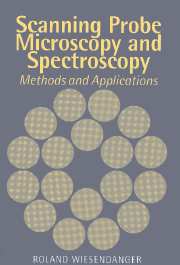Introduction
Published online by Cambridge University Press: 05 October 2010
Summary
The general principle of operation of a scanning tunneling microscope (STM) – and related scanning probe microscopies (SPM) as well – is surprisingly simple. In STM a bias voltage is applied between a sharp metal tip and a conducting sample to be investigated (metal or doped semiconductor). After bringing tip and sample surface within a separation of only a few Ångström units (1 Ångström unit (Å) = 0.1 nanometer (nm) = 10−10 m), a tunneling current can flow due to the quantum mechanical tunneling effect before ‘mechanical point contact’ between tip and sample is reached. The tunneling current can be used to probe physical properties locally at the sample surface as well as to control the separation between tip and sample surface. The distance control based on tunneling is very sensitive to small changes in separation between the two electrodes because the tunneling current is strongly (exponentially) dependent on this separation, as we will see later (section 1.2). By scanning the tip over the sample surface while keeping the tunneling current constant by means of a feedback loop, we can follow the surface contours with the tip which – to a first approximation – will remain at constant distance from the sample surface. By monitoring the vertical position z of the tip as a function of the lateral position (x, y), we can get a three-dimensional image z(x,y) of the sample surface.
- Type
- Chapter
- Information
- Scanning Probe Microscopy and SpectroscopyMethods and Applications, pp. 1 - 8Publisher: Cambridge University PressPrint publication year: 1994
- 1
- Cited by

